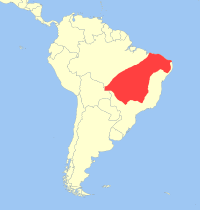Black-striped capuchin
| Black-striped capuchin[1] | |
|---|---|
 | |
| Adult female and juvenile | |
| Conservation status | |
| Scientific classification | |
| Kingdom: | Animalia |
| Phylum: | Chordata |
| Class: | Mammalia |
| Order: | Primates |
| Family: | Cebidae |
| Genus: | Sapajus |
| Species: | S. libidinosus |
| Binomial name | |
| Sapajus libidinosus Spix, 1823 | |
 | |
| Range of S. libidinosus, excluding the subspecies cay and juruanus | |
The black-striped capuchin, Sapajus libidinosus, also known as the bearded capuchin,[2] is a capuchin monkey from South America. It was the first non-ape primate where tool usage was documented in the wild, as individuals have been seen cracking nuts by placing them on a stone "anvil" while hitting them with another large stone.[3] Adaptations to carrying large stones and fruit include strengthened back and leg muscles that permit the monkey to walk on its hind legs while carrying stones.[4] The black-striped capuchin has traditionally been considered a subspecies of the tufted capuchin.[1] On the contrary, the southern population here included in S. libidinosus has sometimes been considered another species, Azaras's capuchin, S. cay (syn. C. paraguayanus).[5]
The black-striped capuchin is found in the Caatinga, Cerrado and Pantanal of Brazil, and forests and woodlands in Paraguay, far eastern Bolivia and northern Argentina.[2][5] Some confusion surrounds the taxon juruanus, here included as a subspecies of the black-striped capuchin.[2] It has been considered to occur from the upper Juruá River east and south to Mato Grosso,[6] or alternatively entirely restricted to the region near the upper Juruá River.[7] In the latter case, its range would be surrounded by C apella, leading to doubts over its true taxonomic status.[8]
Groves (2005) recognizes four subspecies:[1]
- Cebus libidinosus libidinosus
- Cebus libidinosus pallidus
- Cebus libidinosus paraguayanus
- Cebus libidinosus juruanus
In 2011, Jessica Lynch Alfaro et al proposed that the robust capuchins such (formerly the C. apella group) be placed in a separate genus, Sapajus, from the gracile capuchins (formerly the C. capucinus group) which retain the Cebus genus.[9][10]
References
- ↑ 1.0 1.1 1.2 Groves, C. P. (2005). Wilson, D. E.; Reeder, D. M, eds. Mammal Species of the World (3rd ed.). Baltimore: Johns Hopkins University Press. p. 137. OCLC 62265494. ISBN 0-801-88221-4.
- ↑ 2.0 2.1 2.2 2.3 Rylands, A.B. & Kierulff, M.C.M. (2008). "Cebus libidinosus". IUCN Red List of Threatened Species. Version 2011.2. International Union for Conservation of Nature. Retrieved 19 January 2012. Database entry includes a brief justification of why this species is of least concern.
- ↑ Fragaszy, D., Izar, P., Visalberghi, E., Ottoni, E. B., & Gomes de Oliveira, M. (2004). Wild Capuchin Monkeys (Cebus libidinosus) Use Anvils and Stone Pounding Tools. American Journal of Primatology 64: 359–366.
- ↑ "Brazil's Cerrado". Mutant Planet. 2012-08-11. Science Channel.
- ↑ 5.0 5.1 Wallace, R.B. (2008). Cebus cay. In: IUCN 2008. IUCN Red List of Threatened Species. Retrieved 23 November 2008.
- ↑ Groves, C. (2001). Primate Taxonomy. Smithsonian Institution Press. ISBN 1-56098-872-X
- ↑ Fragaszy D., Visalberghi E., & Fedigan, L. (2004). The complete capuchin. Cambridge University Press. ISBN 0-521-66116-1
- ↑ Rylands, A.B., Boubli, J.-P., Mittermeier, R.A. & Wallace, R.B. (2008). Cebus apella. In: IUCN 2008. IUCN Red List of Threatened Species. Retrieved 23 November 2008.
- ↑ Lynch Alfaro, J.W. et al (2011). "Explosive Pleistocene range expansion leads to widespread Amazonian sympatry between robust and gracile capuchin monkeys". Journal of Biogeography. doi:10.1111/j.1365-2699.2011.02609.x.
- ↑ Lynch Alfaro, J.W.; Silva, j. & Rylands, A.B. (2012). "How Different Are Robust and Gracile Capuchin Monkeys? An Argument for the Use of Sapajus and Cebus". American Journal of Primatology: 1–14. doi:10.1002/ajp.222007.
| Wikispecies has information related to: Black-striped Capuchin |
| |||||||||||||||||||||
